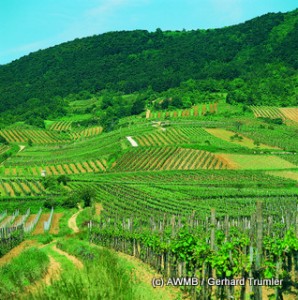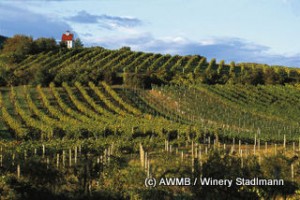Thermenregion whites

Thermenregion
Thermenregion starts on the edge of the Wienerwald forest just 5km south of Vienna. It’s a region of two distinct parts, the result of a merger in 1985. Nearest to Vienna, two niche white grape varieties prevail – rotgipfler and zierfandler.
See later post for the reds of pinot noir and saint laurent, which grow further south.
Rotgipfler and zierfandler have both been around for a long time, and, said Bernhard Stadlmann, of Weingut Stadlmann they “are the two most noble grape varieties of Austria, along with riesling and grüner veltliner.” Neither are widely planted – “there are around 140 hectares of rotgipfler and 120 ha of zierfandler” said Willi Balanjuk of Freigut Thallern, one of the oldest wineries in Austria, founded by Cistercian monks in 1141.
In the north, vineyards lie on an east-south-east facing limestone slope around 200 to 400m above sea level. Balanjuk said this “slightly hillside location, at the east of the Alps, produces concentrated medium bodied wines based on limestone.” The vineyards around Gumpoldskirchen were historically regarded as the most favoured for growing rotgipfler and zierfandler, and these were traditionally blended together, but now are increasing made as single varietal wines.
Both varieties are based on the traminer family so inherent perfume is one of their trademarks, though rotgipfler “has a more constant aromatic profile” said Balanjuk. And where rotgipfler has thicker skins and takes on a green gold hue with ripeness, so zierfandler has thinner skin and takes on a red hue with ripeness, hence is alternative name spätrot.
Rotgipfler’s thicker skins give it some protection against botrytis. Balanjuk said it characteristically has “the honey, yellow melon nose of viognier, plus ripe pear characters of chenin blanc, with a good concentration and texture.” And, he added the aromas develop best in the second year, needing the first year to develop intensity and complexity. Stadlmann added “we see more riper fruit, lush pear, tropical mango, warmer fruit, and warm spice.”

Thermenregion, Mandel-Höh
Rotgipfler’s acidity is fresh but not high, whilst zierfandler “has more acidity than rotgipfler, with a similar structure to riesling” said Stadlmann, and it expresses “colder fruit – lime, lemon, fresh melon, quince, fresh apple, citrus.” These are accentuated in youth, he added, with “fresh green apple, pear, floral notes and some smokiness.” Balanjuk added zierfandler “is a very textured wine, and can be slightly honeyed with the rose leaves of traminer.”
With its thin skin and good acidity levels, zierfandler lends itself to sweet wines. Stadlmann said “we’re not far from Burgenland but the temperature is very different. There are warm nights in Burgenland, but in Thermenregion we always have cool breezes through the vineyards at night, from the mountains.” Sweet zierfandler is not necessarily botrytised, as Stadlmann explained “the fruit can be concentrated on the vine by evaporation through the skin, so you can go to beerenauslese with little botrytis”, adding “some winemakers use 3 or 5% botrytis.”
Mostly, wines are fermented in stainless steel or big old wood, and aged on lees in big wood. This is a good way to harness the aromatic potential without stifling the grapes natural expressiveness and structure. Though hugely niche, these are some tasty whites.
Whilst little rotgipfler or zierfandler is found outside Thermenregion, these two varieties account for around 10% of the region’s total vineyard, keeping their position very specific.
Tasting notes, from a seminar at Vievinum, Vienna, June 2012
Freigut Thallern, Rotgipfler Selektion 2011
Gumpoldskirchen. 13.5%; 5.5 g/l RS; 5.8 g/l TA
Hint of white pepper on the nose, with sweet yellow fruits. Lovely rich yet medium weight texture, with a hint of chalky backbone structure, along with intense, succulent fruit flavours. Long finish. The lighter style of the four in this flight.
Weingut Heinrich Hartl III, Rotgipfler 2010
Oberwaltersdorf. 12.8%; 4.8 g/l RS; 7.5 g/l TA
Hints of aromatic smoke on the nose, followed by ripe yellow fruits, peach and pineapple, with good concentration. Big intensity and freshness with plush, lush fruits.
Weingut Leo Aumann, Rotgipfler Flamming 2010
Tribuswinkel. 13.5%; 2.5 g/l RS; 6.5 g/l TA
Spicy nutmeg and pineapple nose, quite a full palate, rich and plush, with wonderful depth of ripe, sweet fruits. Nothing not to like. Long, round and plush.
Weingut Alphart, Rotgipfler Rodauner Top Selektion, 2010
Traiskirchen. 140%; 6.4 g/l RS; 6.6 g/l TA
Sweet note at the front, tropical fruit, with a feel of gentle vanilla spice very much in the background. This adds an extra dimension to the fruits, which have huge concentration and dimension.
Weingut Biegler, Zierfandler 2011
Gumpoldskirchen. 13.5%; 7.2 g/l RS; 6.2 g/l TA
Lifted melon nose, fresh, clean, almost appley. Pure and crystalline fruits. Hint of phenol support. Aromatic, supple, dry and tasty.
Weingut Gebeshuber, Zierfandler Modler 2010
Gumpoldskirchen. 13.5%; 5.5 g/l RS; 6.3 g/l TA
Tropical and wafting smokiness on nose, fuller body, sweet lush yellow fruits, pineapple, mango, rich and concentrated. Bit of spice in the backbone for a clean dry and long finish. Vg.
Weingut Zierer, Zierfandler Rasslerin 2011
Gumpoldskirchen. 13.5%; 3 g/l RS; 6.2 g/l TA
Rich, sweet fruit, fresh, red apple and citrus along with crystalline pineapple. Lovely intensity and personality. Plush and enticing.
Weingut Stadlmann, Zierfandler Mandel-Höh 2008
Traiskirchen. 13.5%; 8.5 g/l RS; 7 g/l TA
Honey, spice, hint of waxiness, lanolin – some bottle-age notifiers; dry honey. (I prefer the more youthful versions.)
Weingut Piriwe, Zierfandler Trockenbeerenauslese 2007
Traiskirchen. 9.0%; 248 g/l RS; 9.0 g/l TA
Lovely golden colour. Honey, honeysuckle. Marmalade and tangerine notes on the nose. Complex nose, palate fresh and full with rich fruitcake and tangerine pithiness. Very nice.
Comments
One Response to “Thermenregion whites”




August 21, 2013 at 8:50 pm
I love this region, where I was lucky enough to live for a couple of years. Do these wines exhibit terroir ? I don’t know but they are unlike those from anywhere else and ought to be better known.